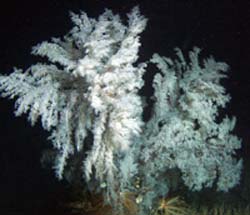New species of coral discovered off southern California

A new species of black coral has been discovered off southern California, including around the Channel Islands, by Milton Love, University of California, Santa Barbara marine researcher, and Mary Yoklavich of NOAA Fisheries. The discovery came during dives by the researchers in “Delta,” the submersible.
The new species, found at depths of approximately 300 to 725 feet, is reported this week in the online scientific journal Zootaxa by taxonomist Dennis Opresko of Oak Ridge National Laboratory. Love named the new species “Christmas Tree Coral” (dendochristos in Greek) since it grows to a height greater than two meters and resembles pink, white and red flocked Christmas trees.
The complete scientific Greek name for the new coral is Antipathes dendrochristos. The word for black coral is “Anti” for against, and “pathos,” for disease, a reference to the fact that black coral amulets were once thought to provide protection against disease and evil spirits.
The Christmas tree coral was first noticed by the researchers during dives for surveys of rockfishes on deep rocky banks about 40 miles off the coast, west of Los Angeles.
Many of the deepwater reefs in southern California harbor remarkably healthy communities of corals, sponges, and other large invertebrates,” said Love. “This may be the case because, historically, there has been relatively little trawling over reefs in our area. What we need to know is the role that these large invertebrates play as deep-water habitats for fishes and other marine life.”
“What is really remarkable,” said biologist Mary Yoklavich from NOAA Fisheries, “is that these spectacular large colonies have managed to go unnoticed while living in the backyard of the largest urban area on the West Coast.”
Media Contact
All latest news from the category: Life Sciences and Chemistry
Articles and reports from the Life Sciences and chemistry area deal with applied and basic research into modern biology, chemistry and human medicine.
Valuable information can be found on a range of life sciences fields including bacteriology, biochemistry, bionics, bioinformatics, biophysics, biotechnology, genetics, geobotany, human biology, marine biology, microbiology, molecular biology, cellular biology, zoology, bioinorganic chemistry, microchemistry and environmental chemistry.
Newest articles

A universal framework for spatial biology
SpatialData is a freely accessible tool to unify and integrate data from different omics technologies accounting for spatial information, which can provide holistic insights into health and disease. Biological processes…

How complex biological processes arise
A $20 million grant from the U.S. National Science Foundation (NSF) will support the establishment and operation of the National Synthesis Center for Emergence in the Molecular and Cellular Sciences (NCEMS) at…

Airborne single-photon lidar system achieves high-resolution 3D imaging
Compact, low-power system opens doors for photon-efficient drone and satellite-based environmental monitoring and mapping. Researchers have developed a compact and lightweight single-photon airborne lidar system that can acquire high-resolution 3D…





















